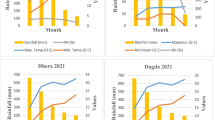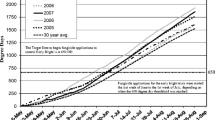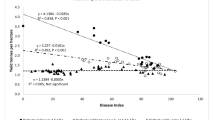Abstract
Ascochyta blight, caused by Didymella rabiei, is the most devastating foliar disease of chickpea in southern Australia. As part of an effort towards developing disease management practices for susceptible cultivars, programs for timing fungicide applications were developed. The efficacy of chlorothalonil and mancozeb in suppressing ascochyta blight was evaluated in five field experiments conducted over 4 years. The results were variable; in some experiments disease was adequately suppressed (control efficacy >89%) whereas in other experiments, control efficacy was insufficient (<32%). Not all of this variability could be explained by differences in the fungicides used or their concentrations. Analysis of the time of spraying in relation to rain events identified possible causes for most of this variability. Ascochyta blight was suppressed when fungicides were applied in time to protect the plants from infections that occurred during rain events, but whenever the plants were not protected during rains, disease suppression was insufficient and control efficacy was low. The coincidence between control efficacy values and the amount of uncontrolled rain was highly significant (P<0.01; R 2 =0.937). Data recorded in the field experiments were then used as input into a series of simulations aimed at quantifying how several management approaches could reduce fungicide use. Results were analysed using multiple regression with dummy variables. Compared with continuous protection of the crop throughout the season, which required eight mancozeb or five chlorothalonil applications, using rain forecast to time sprays may enable a reduction in the number of sprays by up to 5.5 and 2.7 per season, respectively, hence, vastly reducing production costs. Initiating sprays after disease onset (based on monitoring) may enable a further reduction of 0.6 sprays per season, on average. Validation of the threshold amount in Australia for local cultivars and implementation of these strategies awaits examination in field experiments.
Similar content being viewed by others
References
Akem C (1999) Ascochyta blight of chickpea: present status and future priorities. International Journal of Pest Management 45, 131–137. doi: 10.1080/096708799227923
Bruhn JA, Fry WE (1980) Weathering of chlorothalonil residues in a potato canopy. Phytopathology 71, 205.
Cabras P, Angioni A, Garau VL, Melis M, Pirisi FM, Cabitza F, Pala M (2001) The effect of simulated rain on folpet and mancozeb residues on grapes and on vine leaves. Journal of Environmental Science and Health 36, 609–618.
Galloway J, MacLeod WJ (2003) Didymella rabiei, the teleomorph of Ascochyta rabiei, found on chickpea stubble in Western Australia. Australasian Plant Pathology 32, 127–128. doi: 10.1071/AP02076
Gomez D (2000) Diversity amongst South Australian isolates of Ascochyta rabiei. Honours thesis, University of Adelaide, Australia.
ISK — Biotech (1990) ‘Bravo, Daconil 12787. Broad spectrum fungicide.’ (ISK — Biotech Corporation: Mentor, OH)
Jhorar OP, Butler DR, Mathauda SS (1998) Effects of leaf wetness duration, relative humidity, light and dark on infection and sporulation by Didymella rabiei on chickpea. Plant Pathology 47, 586–594. doi: 10.1046/j.1365-3059.1998.0280a.x
Kaiser WJ (1992) Epidemiology of Ascochyta rabiei. In ‘Disease resistance breeding in chickpea—Proceedings of the consular meeting on breeding for disease resistance in Kabuli chickpea’. (Eds KB Singh, MC Saxena) pp. 117–134. (ICARDA: Aleppo)
Kaiser WJ (1997) Inter- and international spread of ascochyta pathogens of chickpea, faba bean, and lentil. Canadian Journal of Plant Pathology 19, 215–224.
Kaiser WJ, Ramsey MD, Makkouk KM, Bretag TW, Acikgoz N, Kumar J, Nutter FW (2000) Foliar diseases of cool season legumes and their control. In ‘Linking research and marketing opportunities for pulses in the 21st century.’ (Ed. R Knight) pp. 437–455. (Kluwer Academic Publishers: Dordrecht)
Khan MSA, Ramsey MD, Corbiere R, Infantino A, Porta-Puglia A, Bouznad Z, Scott ES (1999) Ascochyta blight of chickpea in Australia: identification, pathogenicity and mating type. Plant Pathology 48, 230–234. doi: 10.1046/j.1365-3059.1999.00338.x
Kimber R (2002) Survival and transmission of Ascochyta rabiei (Ascochyta blight) of chickpea. Honours thesis, University of Adelaide, Australia.
Kimber RBE, Ramsey MD, Scott ES (2006a) Factors influencing transmission of Didymella rabiei (ascochyta blight) from inoculated seed of chickpea under controlled conditions. European Journal of Plant Pathology 114, 175–184. doi: 10.1007/s10658-005-4037-z
Kimber RBE, Shtienberg D, Ramsey MD, Scott ES (2006b) The role of seedling infection in epiphytotics of ascochyta blight of chickpea. European Journal of Plant Pathology, in press.
Mathiassen SK, Kirknel PE, Schultz H (1996) Rainfastness and residual activity of some Phytophthora fungicides. In ‘Proceedings of the first workshop of european network for development of an integrated control strategy for potato late blight’. pp. 91–97.
Nasir M, Bretag TW, Kaiser WJ, Meredith KA, Brouwer JB (2000) Screening chickpea germplasm for ascochyta blight resistance. Australasian Plant Pathology 29, 102–107. doi: 10.1071/AP00018
Nene YL (1982) A review of Ascochyta blight of chickpea. Tropical Pest Management 28, 61–70.
Nene YL, Reddy MV (1987) Chickpea diseases and their control. In ‘The chickpea’. (Eds MV Saxena, KB Singh) pp. 233–270. (CAB International: Oxford)
Netter J, Wesserman W, Kutner MH (1985) ‘Applied linear statistical models: regression, analysis of variance, and experimental designs.’ 2nd edn. (RD Irwin: Homewood, IL)
Pande S, Siddique KHM, Kishore GK, Gaur PM, Gowda CLL, Bretag TW, Crouch JH (2005) Ascochyta blight of chickpea (Cicer arientinum L.): a review of biology, pathology, and disease management. Australian Journal of Agricultural Research 56, 317–332. doi: 10.1071/AR04143
Pulse Australia (2005) Crop production. Available at www.pulseaus. com.au/statistics and market overview/crop production/ (verified 15 September 2006)
Ramsey MD, Khan MSA, Scott ES (1999) Ascochyta blight of chickpeas: A lesson in plant disease. Australasian Plant Pathology Society Newsletter 12(2), 9.
Reddy MV, Singh KB (1984) Evaluation of a world collection of chickpea germplasm accessions for resistance to Ascochyta blight. Plant Disease 68, 900–901.
Reddy MV, Singh KB (1990) Management of Ascochyta blight of chickpea through integration of host plant tolerance and foliar spraying of chlorothalonil. Indian Journal of Plant Protection 18, 65–69.
Shtienberg D, Vintal H, Brener S, Retig B (2000) Rational management of Didymella rabiei in chickpea by integration of genotype resistance and post infection application of fungicides. Phytopathology 90, 834–842.
Shtienberg D, Gamliel-Atinsky E, Retig B, Brener S, Dinoor A (2005) The significance of preventing primary infections by Didymella rabiei and development of a model to estimate the maturity of pseudothecia. Plant Disease 89, 1027–1034.
Siddique KHM, Sykes J (1997) Pulse production in Australia past, present and future. Australian Journal of Experimental Agriculture 37, 103–111. doi: 10.1071/EA96068
Singh KB, Hawtin GC, Nene YL, Reddy MV (1981) Resistance in chickpea to Ascochyta rabiei. Plant Disease 65, 586–587.
Taylor PWJ, Ford R (2006) Biology of ascochyta blight of cool season food and feed legumes. In ‘1st International ascochtya workshop on grain legumes’. Keynote-A.
Trapero-Casas A, Kaiser WJ (1992) Influence of temperature, wetness period, plant age, and inoculum concentration on infection and development of ascochyta blight of chickpea. Phytopathology 82, 589–601.
Trapero-Casas A, Navas-Cortes JA, Jimenez-Diaz RM (1996) Airborne ascospores of Didymella rabiei as a major primary inoculum for Ascochyta blight epidemics in chickpea crops in southern Spain. European Journal of Plant Pathology 102, 237–245. doi: 10.1007/BF01877962
Author information
Authors and Affiliations
Corresponding author
Rights and permissions
About this article
Cite this article
Shtienberg, D., Kimber, R.B.E., McMurray, L. et al. Optimisation of the chemical control of ascochyta blight in chickpea. Australasian Plant Pathology 35, 715–724 (2006). https://doi.org/10.1071/AP06069
Received:
Accepted:
Issue Date:
DOI: https://doi.org/10.1071/AP06069




